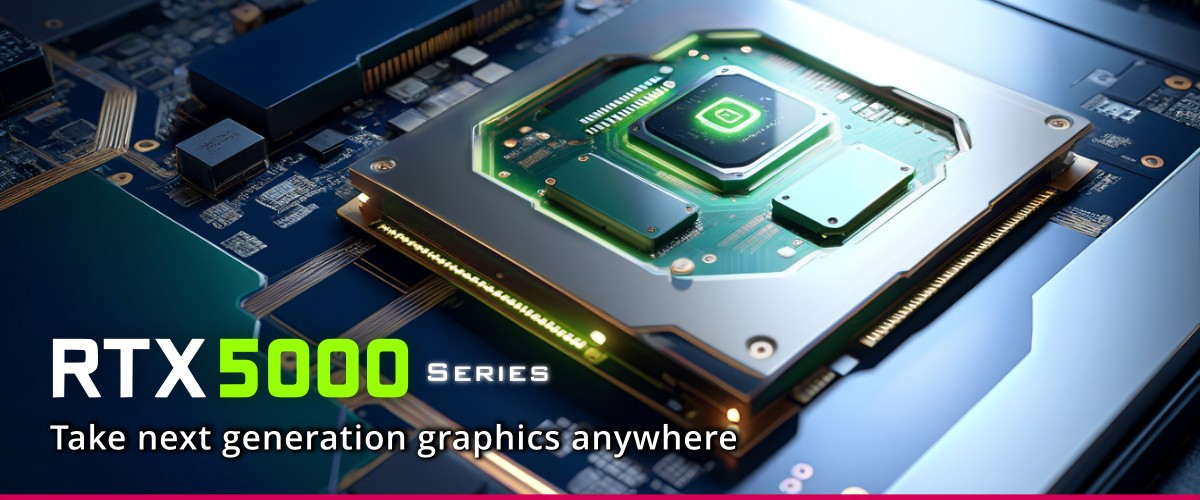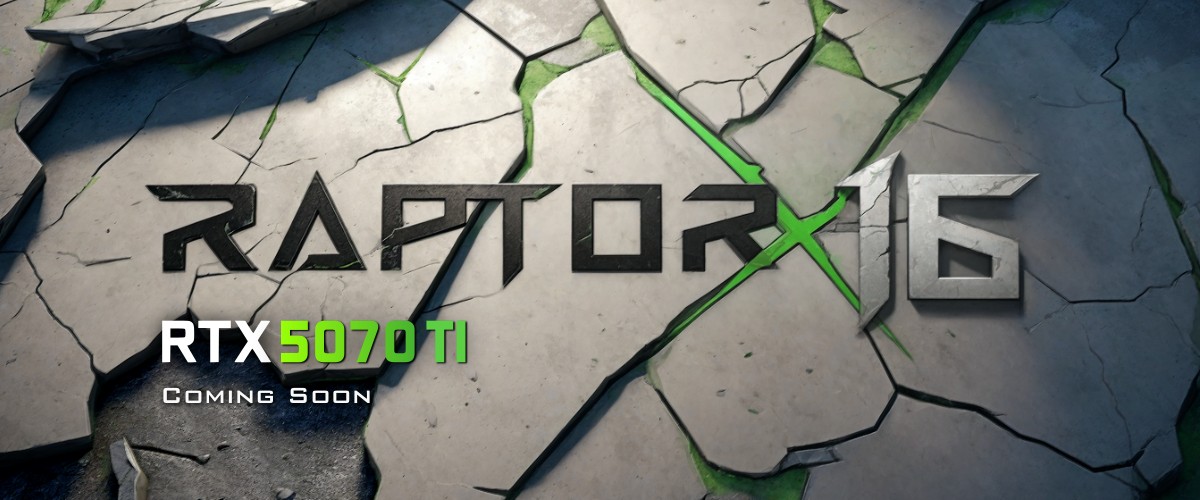
Feb 12, 2025 - sales@eurocom.com
Unleash the power of the RTX 5000 Series:
Customized for your next Laptop
The evolution of graphics technology has brought us to an extraordinary moment. Today, we're thrilled to announce our groundbreaking new lineup featuring NVIDIA's revolutionary RTX50 Series – where impossibility becomes reality.
Introducing the New Raptor X Series
Unleashing the RTX 5000 Series - Power Meets Possibility
We're proud to present two magnificent beasts engineered for maximum impact wherever you live, wherever you go.

The Raptor X16: Portable Perfection
Featuring the NVIDIA GeForce RTX 5070Ti, this 16-inch powerhouse redefines mobile gaming and power computing on the go. It's stunning QHD 240Hz screen renders unprecedented frame rates and visual fidelity that will make you question reality.
With increased capacity of DDR7 VRAM you can drive cutting edge AI graphics models like Stable Diffusion 3.5, SDXL and FLUX - all locally, offline, on your own system with your own data.
And with up to 96GB RAM you can run the latest Large Language Models like DeepSeek R1 (in the mid range of the available distilled sizes). Run AI on your Eurocom Raptor X16 - no cloud required.
With the perfect balance of performance and portability, our new Raptor X16 is designed for anyone - gamer, artist, engineer, AI developer - who refuse to & cannot compromise while on the go.

The Raptor X18: Ultimate Dominance
For those who demand absolute supremacy, the 18-inch Raptor X18 is our juggernaut that will harnesses the full raw power of the all-new NVIDIA GeForce RTX 5090 laptop GPU. This flagship beast pushes the boundaries of what's possible in PC gaming, graphics AI/machine learning and CAD - delivering desktop-class performance in a premium portable format. Rise above limits.
or 24C/24T/36M L3 Graphics NVIDIA GeForce RTX 5090 Memory 256GB DDR5 Storage 32TB of NVMe SSD in RAID 0/1/5
Game Changing NVIDIA GeForce RTX 5090 Graphics
Built on NVIDIA’s Blackwell architecture, the NVIDIA GeForce RTX 5090 on board the Raptor X18 redefines performance boundaries with precision-engineered advancements tailored for gamers and creators. The redesigned streaming multiprocessors and next-gen RT cores deliver hyper-efficient ray tracing, while Blackwell’s upgraded tensor cores accelerate AI-driven rendering at scale. NVIDIA DLSS 4 introduces refined temporal upscaling algorithms, boosting frame rates without compromising geometric detail, and supports dynamic resolution scaling for seamless 4K/8K output.
For creators, Blackwell’s expanded neural rendering pipelines optimize tasks like generative AI creation and photorealistic 3D rendering, leveraging FP8 precision to accelerate workflows. Enhanced GDDR7 memory bandwidth reduces latency in data-heavy applications, and a rebalanced power architecture ensures thermal efficiency under sustained loads.
With the increased computational density and VRAM capacity, higher than any available in laptops before, it's possible to run even bigger and more complex AI workflows with local, offline, bleedinge edge image/video generation models such as Stable Diffusion and FLUX.
The NVIDIA GeForce RTX 5090 architecture incorporates 328 dedicated tensor cores, leveraging parallelized matrix operation acceleration to optimize mixed-precision (FP16/FP32) computational throughput, thereby reducing latency and enhancing scalability in deep learning training and inference workloads.
Take an enormous 256GB of RAM wherever you go
256GB isn’t about raw speed—it’s about eliminating compromise: no more "simplify the scene," "quantize the model," or "close your tabs." It shifts bottlenecks from memory management to pure compute/algorithmic limits, letting GPUs/CPUs operate at peak utilization. For LLMs/CAD, it’s transformative; for gaming/art, it’s luxury headroom—but always a shield against "what if?" scenarios.
Gaming (The Overkill Advantage)
Modern games rarely exceed 32GB of RAM usage, even at 4K. However, 256GB unlocks niche scenarios:
• Massive modding ecosystems: Load thousands of high-res texture mods simultaneously (ie- Skyrim or Cities: Skylines II with 50GB+ asset libraries) without stuttering.
• Background process immunity: Stream, record 8K60 HDR gameplay, and run Discord/Chrome without competing for memory bandwidth.
• Future-proofing for UE5 Nanite: Engineered for virtualized geometry, Nanite’s micro-polygon streaming could leverage excess RAM as a cache for extreme LOD transitions.
While GPU VRAM, not system RAM, remains the primary bottleneck for gaming visuals - a Raptor X18 256GB configuration yield key performance advantages that go beyond frame rate and visual fidelity.
Local LLMs - Secure Offline Brain
256GB transforms consumer hardware into an LLM workstation.
• Run 70B+ parameter models natively (ex- LLaMA-3 70B) at FP16 precision (~140GB memory footprint) without quantization compromises - or bleeding edge models like like DeepSeek R1 in configurations that can rival that of cloud providers - all on your system, your network.
• Batch inference: Process multiple 8k-token prompts in parallel (ex- generate code, analyze documents) at >30 tokens/sec.
• Fine-tuning flexibility: Train smaller adapters (LoRA) on domain-specific datasets in-memory, avoiding SSD bottlenecks. Contrast with gaming: LLMs are memory-bound—256GB isn’t luxury, it’s mandatory for full-precision, large-model operation.
Digital Art & 3D - Canvas Unconstrained
• Photoshop/ZBrush: Work with 16K+ canvases (ex- 10-layer concept art) or 100M+ polygon sculpts without splitting subtools. RAM acts as a "live undo buffer" for non-destructive workflows.
• Blender/Maya Viewport fluidity: Keep multi-billion poly scenes (CAD imports, VFX assets) fully cached, avoiding proxy-geometry swaps.
• Simulation pre-baking: Store complex cloth/fluid solves in-memory for real-time scrubbing during iteration.
• Render farms on a desk: Use RAM as a scratch disk for GPU/CPU renderers (ex- Cycles, Arnold) to handle out-of-core geometry. Unlike gaming, these apps scale linearly with RAM—more headroom = fewer workflow interruptions.
CAD - Precision Engine
For SolidWorks, AutoCAD, or CATIA,
• Assembly megaprojects: Load entire aircraft/automotive assemblies (10,000+ parts) with real-time interference checking.
• FEA/CFD acceleration: Solve finite element models in RAM (e.g., 20M-node thermal analysis) instead of swapping to SSDs.
• Point cloud processing: Edit lidar scans of industrial sites (>1B points) without decimation. CAD has unique demands that rely on single-threaded operations for tasks like constraint solving. Excess RAM ensures background data (BOMs, PLM metadata) stays resident, avoiding thread stalls.
32TB of NVMe Storage - Eliminating Compromise Across Demanding Workloads
For gamers, the Raptor's capacity of 32TB of SSD transforms the concept a laptop into a portable vault: install every AAA title you have (modern games hit 100-200GB each), entire mod libraries (4K texture packs, fan-made expansions), and even legacy collections—all accessible at near-instant NVMe speeds. DirectStorage API leverages this bandwidth to slash load times, while future-proofing for Unreal Engine 5’s Nanite virtualized assets. Video editors gain similar freedom: store months of 8K RAW footage and proxies on a single device, enabling seamless timeline scrubbing without external drives. AI/ML workflows thrive with space for multi-terabyte datasets (e.g., 100M+ image training sets) alongside local copies of 70B+ parameter LLMs, avoiding cloud dependency.
For CAD and 3D engineering, 32TB lets you hoard decade-long project archives—massive assemblies, FEA simulations, and lidar scans—on-device. Complex renders and simulations run faster when source files aren’t throttled by network storage latency. Creators using tools like Blender or ZBrush avoid SSD “hamster wheel” management; keep every iteration, texture atlas, and sculpt layer immediately accessible.
The real advantage? Momentum. No pauses to delete files, swap drives, or wait for cloud sync. NVMe’s parallel lanes let games load assets, AI models batch-process prompts, and video editors layer 8K streams simultaneously—turning storage from a bottleneck into a silent, high-speed foundation for whatever comes next.
Intel Core Ultra 275 HX Series Chip Inside
Intel's new Core Ultra 200 HX series CPUs, Arrow Lake-H, feature the latest silicon designed with more overclocking features and data-lanes than ever. Intel has addressed power consumption bottlenecks from past chips and has designed it to synergize with the dGPU for max performance.
The H-series chips are based on the desktop Ultra 9 platform, designed for high-performance laptops that require the most demanding processing, rich creative tasks & engineering on the go. Initial results are making it clear tha the new platform has accomoplished these goals.
Intel Core Ultra i9 275HX
Cores 24 Threads 24 Speed 5.4 GHz GPU Cores 4 NPU TOPS 13Inquire about Pre-Ordering
Be among the first to experience the future of graphics. Pre-orders will open before our anticipated spring release date, with limited quantities available at launch. Join us in the exciting new landscape of Eurocom tech.
Email our team sales@eurocom.com today.
~ The EUROCOM Team ~